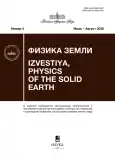The study analyzes the development of the aftershock process, displacements at GNSS (GPS) stations, and time variations of the gravity field in the area of the Simushir earthquakes on November 15, 2006 and January 13, 2007. A simulation of the post-seismic creep and the viscoelastic relaxation process with an asthenospheric viscosity of 1019 Pa·s has been performed. It is shown that the nature of the displacements at GNSS stations, the growth of the gravity anomaly, which began 5 months after the earthquake of November 15, 2006, simultaneously with the advance of aftershock activity to a depth of 100 km, are mainly associated with postseismic creep in a vast area, including areas of the subduction zone adjacent to the focal zone and its continuation to a depth of 100 km. Approximately 20% of the displacements are attributed to the action of viscoelastic relaxation. It is concluded that the features of many processes occurring in the southern part of the Kuril Arc may be related to the fact that the direction of the Pacific plate movement here is not perpendicular to the oceanic trench; the so-called oblique subduction takes place. The emerging component of the right-lateral strike-slip is realized not only in the back-arc basin, as it occurs, for example, in the Andaman Sea, but also at the plate contact itself. This leads to the formation of an extension and destruction zone, revealed by geophysical work in the area of the subduction zone from the Bussol Strait to the Diana Strait. Sharp changes in the depth of the acoustic basement and the Moho boundary were recorded at the edges of this zone, Moho was not recorded in the destruction zone itself. This area has been a seismic quiescence for a long time and two strong events occurred in it on November 15, 2006 and January 13, 2007. The postseismic creep model constructed in this study shows that in the area of extension and destruction, the displacements, along with the thrust component, also had a right-lateral strike-slip component. To the north of this zone, in the area of the Ketoy and Matua Islands, purely thrust displacements occurred, further to the north the magnitude of the displacements decreases.
 4-20
4-20


 21-34
21-34


 35-49
35-49


 50-62
50-62


 63-79
63-79


 80-92
80-92


 93-114
93-114


 115-133
115-133


 134-143
134-143


 144-158
144-158


 159-177
159-177


 178-186
178-186


 187-198
187-198


 199-215
199-215


 216-236
216-236


 237-252
237-252











